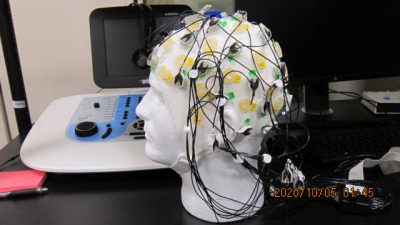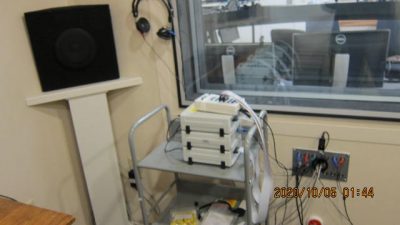
Neurophysiologic Recordings
Cochlear implants can help people with hearing loss, but successful rehabilitation depends on how sound is used by the brain. We therefore use methods for measuring auditory evoked potentials - the electrical signals produced by the auditory centers in the brain - to determine how the auditory function of the brain changes with various sounds. In particular, we record and analyze cortical auditory evoked potentials (CAEP) in listeners with and without hearing loss.
The recording of evoked potentials in response to cochlear implant stimulation is problematic because the use of electrical stimulation results in a stimulus artifact that can obscure the much smaller neural signals. One of the aims of the lab is to develop new methods, including wavelet-based methods, to greatly reduce the effect of the stimulus artifact and so enhance our analysis of neural responses.
Aging
Many listeners with hearing loss are elderly, but the effect of aging on how the brain processes sound is still poorly understood. To greater understanding, we perform experiment with listeners who have normal hearing for their age and with listeners who use a cochlear implant. We perform psychophysical studies to quantitatively determine the limits of hearing, how it relates to the stimuli, and how it is affected by age. In an ongoing study, for example, we are investigating the ability of older and younger listeners to use the temporal envelope of sounds to discriminate sounds that have different fundamental frequencies. A key aim of this study is to determine how this ability relates to real-life listening situations such as speech understanding in quiet and noise and prosody recognition - the critical component of communication that enables us to decide whether a utterance is a statement or a question, the speaker is a female or a male, or the speaker is for example happy, sad, or anxious.


Facilities
The Cochlear Implant Brain and Behavior Lab area has a sound booth for conducting listening tests in quiet environments. We use this booth for experiments with participants who have normal hearing and participants who have a cochlear implant. Some cochlear implant experiments are carried out with the participants own cochlear implant, where we present sounds from a loudspeaker that are picked up and processed by the speech processor worn by the participant. In such experiments we never change the settings of the speech processor so participants can be assured that they go home with the same settings as when they arrived. In other experiments we use direct stimulation using equipment provided by cochlear implant manufacturers that enables us to very exactly control the stimuli that is presented to a participant. If you have a cochlear implant and would like to participate in our research, please see our list of current studies. We occasionally also require older participants who have normal hearing for their age.
In some experiments we are interested in the electrical signals evoked in the brain in response to sounds or cochlear implant signals. To make these measurements we use the BRAIN VISION BrainAmp MR system to record cortical auditory evoked responses (CAEP) and the V-amp system to record subcortical responses.
Funding
Our work is currently funded by ??. Please contact us if you would like to discus how you can fund our research.